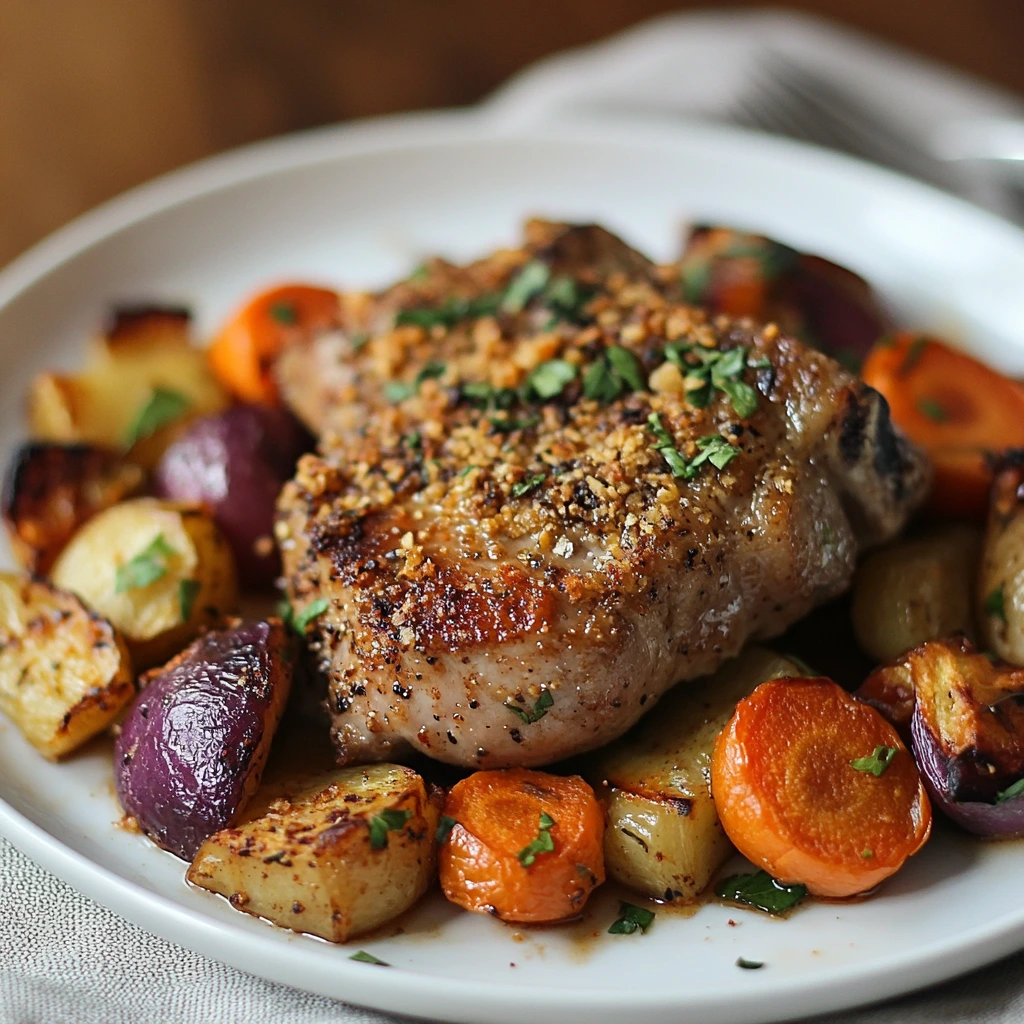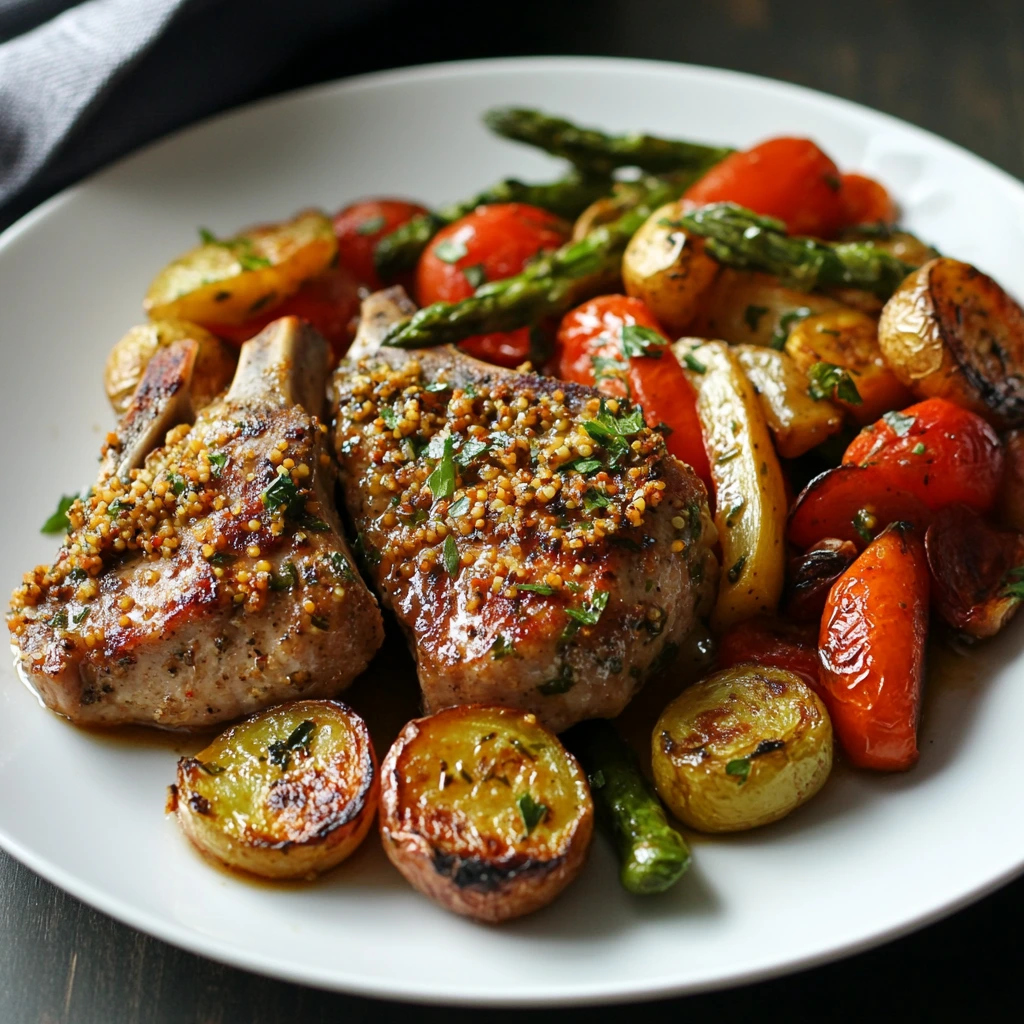Part 1: Introduction and Overview
Hook: A Savory Delight for Weeknight Dinners
Imagine biting into a perfectly crusted pork chop, the tangy mustard and crispy breadcrumb coating delivering bold flavor with every bite. Paired with tender, caramelized roasted vegetables, this dish transforms an ordinary dinner into a gourmet experience—without the hassle.
Why Mustard-Crusted Pork Chops Are a Flavorful Option
Mustard-crusted pork chops bring together simplicity and sophistication. The tangy sharpness of Dijon mustard blends beautifully with the savory crunch of breadcrumbs, creating a delightful contrast. These chops are versatile, easy to prepare, and offer a restaurant-quality meal from the comfort of your kitchen.
Highlight the Appeal of Roasted Vegetables as a Wholesome Side Dish
Roasted vegetables are the perfect companion to mustard-crusted pork chops. With their natural sweetness enhanced through roasting, they complement the savory richness of the pork. Plus, they’re customizable—use seasonal vegetables for a dish that’s both nutritious and budget-friendly.
Ingredients and Preparation
Section 1: Key Ingredients
Mustard Crusted Pork Chops
- Types of Mustard:
The choice of mustard is key to the flavor profile of this dish. Dijon mustard is commonly used for its smooth texture and tangy flavor, but you can also opt for grainy mustard for a bit more texture or yellow mustard for a milder taste. Each type of mustard will give the pork a distinct kick, so choose according to your preference. - Cuts of Pork:
Both bone-in and boneless pork chops work well in this recipe. Bone-in chops tend to be juicier and more flavorful due to the bone marrow, while boneless chops are quicker to cook and easier to slice. Choose based on your cooking time and preference for tenderness.
Roasted Vegetables
- Choosing Vegetables:
A mix of carrots, Brussels sprouts, and potatoes is a classic combination for roasting. These vegetables hold up well in the oven and develop a lovely caramelized exterior. However, feel free to swap in other veggies based on seasonality or personal taste. Sweet potatoes, cauliflower, or parsnips make excellent additions or replacements. - Seasonings to Enhance Flavor:
Roasted vegetables shine when seasoned properly. Olive oil is the base for coating the veggies, helping them crisp up in the oven. Garlic, either minced or whole, adds depth, while fresh thyme complements the earthy flavors of the vegetables. A sprinkle of salt and pepper is essential for bringing out the natural sweetness of the vegetables.
Optional Additions and Substitutes
- Alternative Mustards or Breading Options:
For a different twist, try using whole grain mustard for a more robust flavor or honey mustard for a touch of sweetness. You can also experiment with different breading options: panko breadcrumbs provide a lighter, crunchier texture, while gluten-free breadcrumbs can be used for those with dietary restrictions. - Swap Vegetable Varieties Based on Seasonality:
Depending on the season, you can switch up the vegetables. Summer squash and zucchini are great choices in the warmer months, while root vegetables like rutabaga or turnips are ideal for fall and winter. This allows you to make the dish year-round with fresh, seasonal produce.
Section 2: Preparation Instructions
Prepping Pork Chops
- How to Marinate or Apply Mustard Crust:
Start by patting the pork chops dry with paper towels. This will help the mustard adhere better. Spread a generous layer of Dijon mustard on both sides of each pork chop. You can let the pork marinate for up to an hour to allow the flavors to infuse, though this step is optional. The mustard acts as both a binder and flavor booster, so don’t skip this step. - Tips for Even Seasoning and Sealing Moisture:
After applying mustard, season the pork chops with salt, pepper, and any other herbs you like—rosemary or thyme pair wonderfully. Coat the pork chops in breadcrumbs to form a crispy crust. Press the breadcrumbs lightly so they stick, ensuring the crust stays intact during cooking. If you have time, let the coated pork chops sit in the fridge for 15-30 minutes to set the crust.
Preparing Vegetables
- How to Cut Vegetables for Even Roasting:
To ensure that your vegetables cook evenly, cut them into similar-sized pieces. For instance, carrots should be cut into thin rounds or sticks, potatoes into wedges, and Brussels sprouts should be halved. This ensures everything roasts uniformly and avoids some pieces being undercooked while others are overcooked. - Mixing Vegetables with Seasoning and Oil:
In a large mixing bowl, toss your vegetables with olive oil, minced garlic, fresh thyme, and a pinch of salt and pepper. Make sure each piece is evenly coated. For a slightly caramelized exterior, make sure the vegetables are spread out in a single layer on the baking sheet, leaving enough space for air circulation.
Tools Needed
- Baking Trays:
You’ll need a sturdy baking tray or sheet pan to cook both the pork chops and vegetables. A rimmed baking sheet works best to catch any juices from the pork while it cooks. Make sure the vegetables are spread out in a single layer to allow even roasting. - Meat Thermometer:
A meat thermometer is essential to ensure your pork chops are cooked to the right temperature. Pork should be cooked to an internal temperature of 145°F for optimal juiciness. This ensures that your mustard-crusted pork chops are safe to eat while remaining tender and juicy. - Other Kitchen Essentials:
You’ll also need mixing bowls for coating the pork chops and tossing vegetables, a basting brush if you’re adding any glazes, and tongs for handling the pork chops and vegetables without disturbing the crust.
FAQs and Final Thoughts
FAQs
- What type of mustard is best for pork chops?
Dijon mustard is the most commonly used type for its tangy flavor and smooth texture, but you can also use grainy mustard for a more rustic, bold taste. Yellow mustard works well for a milder flavor, while whole grain mustard provides extra texture. Choose based on your preference for sharpness and texture. - Can I use frozen vegetables for roasting?
Yes, you can use frozen vegetables, but they tend to release more moisture during cooking, which can result in a less crispy texture. To counter this, make sure to thoroughly dry the vegetables before roasting and avoid overcrowding the pan. You may need to roast them a bit longer than fresh vegetables to achieve the desired crispness. - How do I store and reheat leftovers?
Store leftover pork chops and roasted vegetables in airtight containers in the refrigerator for up to 3 days. To reheat, place the pork chops in a preheated oven at 350°F (175°C) for 10-12 minutes, or until warmed through. For the vegetables, you can reheat them in the oven or a skillet for best results, ensuring they stay crispy. - What can I substitute for pork chops in this recipe?
If you prefer an alternative to pork chops, chicken breasts or chicken thighs can be great substitutes. For a plant-based option, tofu steaks or tempeh can be coated with mustard and roasted with similar seasonings. These substitutions offer a slightly different flavor but still provide a hearty, satisfying dish.
Final Thoughts
This mustard-crusted pork chops with roasted vegetables recipe is not only easy to make, but it’s also incredibly versatile and customizable to your tastes. With minimal prep and cooking time, it’s perfect for busy weeknights or casual gatherings. Feel free to experiment with different crusts, vegetables, and sides to make it your own. We encourage you to try new variations and share your experience—this dish is all about enjoying the simplicity of wholesome, flavorful ingredients!




